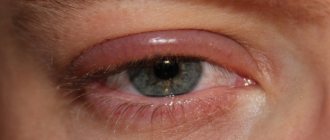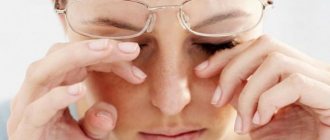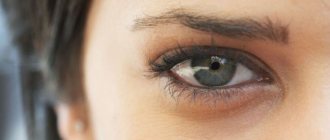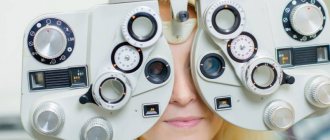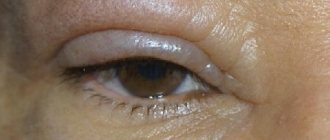Allergy is a condition characterized by increased sensitivity of the immune system to certain irritants. One of the most common manifestations of the disease is swelling of the eyes and eyelids. The organs of vision are susceptible to negative effects that can come from the external environment or the human body.
Allergies most often affect the upper eyelid. If both are affected, this indicates an advanced form of the disease, which requires immediate medical attention.
Share
Tweet
Share
Cool
Send
Why do my eyelids swell?
Swelling occurs due to exposure to allergens.
In adults
The appearance of edema in adults is due to several reasons:
- food allergies:
- insect bites;
- reaction to sunlight or cold;
- contact with subcutaneous mites, which can get onto the eyelids from glasses frames;
- tattoo;
- contact with animals;
- use of cosmetics;
- influence of dust and pollen;
- use of medications;
- contact with chemicals.
In children?
Children are more susceptible to allergies than adults. The child's immunity is in its infancy. Swelling can be caused by allergenic foods, household chemicals, saliva and animal hair, pollen, medications, and insect bites. Cold weather or bright sun can be a provoking factor.
Allergens
Allergens are antigens that cause an allergic reaction. The immune system perceives them as foreign particles, resulting in swelling and inflammation. Food allergens include:
- chicken meat;
- cow's milk;
- fish;
- peanut;
- seafood;
- chicken eggs;
- honey;
- strawberries and strawberries;
- citrus;
- pumpkin;
- carrot;
- beet;
- chocolate;
- mushrooms.
During the flowering period, hay fever develops - a reaction to pollen. Allergic edema is caused by:
- birch;
- poplar;
- oak;
- chestnut;
- spruce;
- pine;
- cherry;
- Apple tree;
- apricot;
- raspberries;
- rose hip;
- cherries;
- plum;
- dill;
- ambrosia;
- sagebrush.
Among household chemicals, washing powders, dishwashing detergents, stain removers, polishes, bleaches and air fresheners are dangerous. Allergies are triggered by house dust, which contains fungal spores, bacteria, animal fluff, skin particles and micro mites. A reaction may occur when using creams and eyeliner.
Drug allergens include radiopaque substances, albumin, antibiotics, serums, vaccines, sulfonamides. Swelling occurs after bites from bees, wasps, fleas, bedbugs and mosquitoes. And also due to contact with animals. Allergies are triggered by substances found in the sweat glands, saliva and skin, which are absorbed by hair and fluff.
Symptoms
An allergic reaction can be recognized by several signs.
Manifestations of conjunctivitis
The following signs indicate conjunctivitis:
- itching in the eyes;
- burning;
- blurred vision;
- inflammation of the eyelids;
- redness;
- dilation of blood vessels;
- lacrimation.
With conjunctivitis, the outer layer of the eyeball becomes inflamed.
Signs of angioedema reaction
With angioedema, also known as angioedema, the eyelids become very swollen. The patient's palpebral fissures may completely close. Edema affects the skin, subcutaneous fat and mucous membranes.
This condition is characterized by a sudden appearance and rapid development, which takes from 5 to 30 minutes. The patient experiences a feeling of skin tension. Edema can spread to the upper respiratory tract: nasopharynx, pharynx, larynx, trachea, bronchi. This will lead to difficulty breathing.
How to quickly remove allergic swelling from the eyes?
Eye swelling caused by exposure to an allergen is not uncommon. The allergen in this case can be plant fluff and pollen, substances with a strong odor, medicines and perfumes, food products, and pets.
The following symptoms are characteristic of eye swelling due to allergies:
- itching of the skin of the eyelids;
- redness of the mucous membranes of the eyes and eyelids;
- lacrimation;
- feeling of sand in the eye when blinking.
Since the impact of the allergen is often not limited to the eye area, additional symptoms of allergic eye swelling may be as follows:
- nasal congestion;
- rhinitis;
- copious glassy discharge from the nose;
- sore throat;
- labored breathing;
- dry cough;
- skin rash;
- itching
Eliminating the allergen
As with any allergy, the most effective treatment is to identify and then eliminate the allergen.
With medications and cosmetics this is quite easy to do. It is enough to analyze after using which remedy the condition worsened. The situation is more complicated if the allergen is a food product or its components (spices, preservatives, dyes).
In this case, patients are advised to refrain from eating for 24 hours. In the future, it is necessary to introduce hypoallergenic foods into the diet one by one and take into account the changes occurring in the body. The appearance of swelling and other signs of allergy may indicate a dangerous product that can cause an allergic reaction.
What to do if a patient’s allergic eye swelling is caused by a pollen allergen? This cause of the disease can be assumed based on the deterioration of the condition with the arrival of spring and the flowering of plants.
In this case, it will be possible to eliminate the allergen only by changing your place of residence.
In cases where it is difficult to make such a radical decision, and the allergy symptoms are very pronounced and significantly worsen the quality of life of patients, they turn to specific immunotherapy (SIT).
Drug treatment
SIT consists of injecting small doses of an allergen over a long period of time, developing the body’s addiction. Currently, this method of treating allergies is considered the most effective for hay fever. However, using it will not quickly remove allergic swelling from the eyes.
The implementation of SIT is planned for several years.
This method can be used while continuing to use traditional medications for the treatment of allergic eye swelling, such as
- antihistamines;
- corticosteroids;
- detoxification agents;
- sorbents.
Among the antihistamines used to treat eye swelling due to allergies, Claritin, Cetrin, and Telfast have proven themselves to be the best.
They belong to the third generation of this group of drugs and do not have such side effects as drowsiness, impaired attention, dry mouth.
To a much lesser extent, addiction develops to them. In addition, they have a fast and very effective effect.
The use of prednisolone is due to its pronounced anti-inflammatory, decongestant and antihistamine effect. The drug can be used both in tablet and injection form. In modern medicine, corticosteroids are the most powerful antiallergic drugs, widely used as emergency treatment drugs.
However, these drugs also have serious side effects, such as increased blood pressure, increased blood sugar levels, and the development of ulcer bleeding, which significantly limits their use.
To relieve allergic swelling from the eyes, another form of release of this drug can be used - eye drops with prednisolone or dexamethasone.
Unlike tablet or injectable drugs that affect the entire body, drops act locally and, therefore, do not have significant side effects.
In cases of pathology of the organ of vision and swelling of the eye, they are irreplaceable.
Angioedema
A severe manifestation of allergies is angioedema, or, according to the author who described it, angioedema. The disease develops over several minutes or hours and is manifested by severe swelling of certain organs or parts of the body. The most typical swelling is the respiratory organs, face, and genitals.
Damage to the larynx and tongue is a serious complication of Quincke's edema, as it can lead to asphyxia.
Symptoms of laryngeal edema, in addition to hoarseness and difficulty breathing, are an increase in respiratory failure, which requires urgent action. In addition, swelling of the face is also dangerous due to the possibility of developing cerebral edema, which is manifested by neurological symptoms with the development of meningeal signs, impaired consciousness, and seizures.
Lips and eyelids are also quite common localizations of Quincke's edema. Quincke's edema in the eyes is characterized by the rapid development of symptoms and significant swelling. The palpebral fissure is sharply narrowed.
This pathology is not accompanied by pain. On palpation, the swelling is painless and has an elastic consistency. When you press on the site of swelling, there is no hole left.
Quincke's edema is often accompanied by a sharp decrease in blood pressure and the development of shock.
Emergency measures for angioedema should begin even before the ambulance arrives.
Since in most cases the development of the reaction is caused by exposure to an allergen, it should be excluded. At home, it is necessary to give an antihistamine to the patient. To achieve the fastest possible effect, it is better to apply it under the tongue.
Before the arrival of specialists, the patient should be in a cool place with maximum access to oxygen (windows are open, clothing collars are unbuttoned). While in a horizontal position, the foot end of the bed should be raised.
The patient can also sit if this makes breathing easier.
Urgent measures
Emergency measures for Quincke's edema in the eyes, carried out by specialists, include:
- hormone therapy (administration of prednisone);
- use of injectable antihistamines (suprastin, tavegil);
- detoxification therapy (saline drip, 5% glucose solution);
- using diuretics (Lasix).
In case of further deterioration of the condition and a drop in blood pressure, the administration of adrenaline is indicated. In this case, the patient must be hospitalized. Correct therapy allows you to relieve angioedema within a few hours or days without leaving a trace.
However, the re-development of such a reaction cannot be ruled out. The presence of allergies when the eyes are swollen is also dangerous due to its possible complications, such as swelling of the brain, larynx or urinary system, accompanied by acute urinary retention.
Consequently, the entire recovery period should take place under the direct participation of a specialist in a hospital setting.
//www.youtube.com/watch?v=vp-N2e4Si-w
Gaevaya Natalya
Sources: medscape.com, mdlinx.com, health.harvard.edu.
Source: //roddom32.ru/zabolevaniya/oteki/glaza-pri-allergii.html
Diagnostics
Diagnostics is complex and includes several methods. One of the most informative tests is skin testing. Solutions with allergens are applied to the patient's forearm. Then a small incision or puncture is made in these places. If you have an allergy, swelling and redness will appear within 15-20 minutes.
Tests are not performed on patients under 3 and after 60 years of age. In young children, the immune defense is not sufficiently developed, and in older people it may be weakened. Skin tests are contraindicated during exacerbation of allergies or other diseases, pregnancy and acute respiratory infections.
To obtain an accurate result, the patient should not take antihistamines two days before the test.
A blood test is taken from the patient to determine the total level of immunoglobulin E. These are antibodies that interact with allergens. In terms of reliability, this method is inferior to skin testing. But it allows you to identify allergies if the patient is taking medications that he cannot refuse during the examination period. For skin diseases and the possibility of a strong reaction to the skin test. The analysis is taken from children who are afraid to take tests.
How to relieve swelling from the eye due to allergies
Eyelid allergies are one of the most common forms of allergic reactions in the human body. And all because the eyes are constantly exposed to irritants that are in the environment. Swelling traditionally manifests itself in the upper eyelid, although it can also occur in the lower eyelid, accompanied by tearing and itching.
General concepts about allergies
Throughout the life of every person, he is accompanied by tiny organisms that are contained in the air, water, vegetables, fruits, etc. Someone may not even see the presence of one or another irritant, but a person suffering from allergies will feel them regardless of whether he wants it or not.
Allergens floating in the air are deposited on all mucous membranes. One of the most accessible and vulnerable membranes is the mucous membrane of the eye.
The general worldview that allergic swelling of the eyelids occurs only as a result of the action of an allergen specifically on the mucous membrane is erroneous. Eye swelling can be caused by hyperallergenic foods or pharmaceuticals, the components of which a person has a personal intolerance to.
If contact with the allergen took place through the mucous membrane of the eyes, then the reaction can be expected within 30 minutes.
If the irritant enters the body with food, then it takes a little more time for it to enter the bloodstream and reach the mucous membrane of the eyelids. Allergic swelling in the eyes can be a consequence of: an insect bite, taking pharmaceuticals, inhaling plant pollen, evaporation of chemicals, another disease, etc.
Symptoms of allergies on the eyelids
Symptoms, their severity and duration will depend on how many allergens are in the body, as well as on the sensitivity of the immune system.
Allergies on the eyelids are accompanied by the following symptoms (see photo):
- itching;
- tearfulness;
- burning or pain;
- swelling of the eyelids;
- swelling of the conjunctiva;
- redness of the eyes;
- severe sensitivity to light (especially bright);
- feeling of lethargy and heaviness in the eyelids.
Allergic swelling may be insignificant and resemble the effect of tear-stained eyes, but with severe manifestations of allergic reactions, the eyes may not actually open.
Swelling is traditionally in such cases accompanied by pain and pain in the eyes.
Swelling can occur on the upper and lower eyelids at once. The extent of allergic edema sometimes extends to the entire face and other parts of the eyeball: cornea, membrane, optic nerve, uveal tract and retrobulbar tissue.
Intraocular pressure increases. Such powerful swelling of the eyelids is fraught with a decrease in vision or its complete loss.
Diagnosis of allergic swelling
It is not difficult for a doctor to find allergic swelling of the eyelids, but for the most complete picture of the disease it is recommended to undergo a series of examinations and tests:
- a blood test to identify the allergen;
- consultation with an ophthalmologist, especially if the manifestations of allergies are accompanied by an infection;
- consultation with an otolaryngologist if there is chronic inflammation in the paranasal sinuses.
Treatment of allergic manifestations in the eyes
Like any other treatment, allergic swelling of the eyelids must first be correctly diagnosed in order to find the irritant that caused such a reaction in the body and eliminate its influence.
Symptoms can be relieved with the following medications:
- Antihistamine eye drops.
They are able to relieve swelling and itching for a short period of time. - Hormonal eye ointments. Prescribed for inflammatory conditions and relieve allergic swelling.
- Antihistamines for oral administration.
They help get rid of the consequences of allergies, such as a runny nose or cough. - To eliminate redness of the eyes, vasoconstrictor eye drops are prescribed.
If contact with the allergen cannot be eliminated for any reason, treatment with medication is not prescribed. As a matter of urgency, the patient should be admitted to the hospital. Allergies on the eyelids in such a situation can be eliminated with the help of a course of immune therapy.
Healing is done by subcutaneous injection of the allergen in small doses. During therapy, the dose is gradually increased. The main goal of this method is to reduce the body’s susceptibility to the allergen by stimulating the immune system.
Preventive measures
The only thing that can save a person who suffers from allergies is avoiding contact with the allergen. This is the most effective method of prevention, which will reduce the frequency of relapses and cure one hundred percent. To reduce the risk of allergies and their consequences, you should:
- Minimize the use of decorative cosmetics or avoid them completely.
It can be replaced with cosmetics marked “hypoallergenic” and selected according to age categories. - During the flowering period of gardens and other vegetation, you need to reduce the time spent outside.
You can go for a walk only when there is calm outside. The same applies to ventilation of the room. - Try to eat only those foods that cannot cause allergic reactions, even if you think that the food has nothing to do with allergic eye swelling. Some foods can provoke an exacerbation of an existing allergy.
- Rules of personal hygiene. Be sure to wash your hands after returning from the street or other activities to prevent allergen nanoparticles from getting into the mucous membrane of the eyes.
If you have an allergy (even if it is not present at the moment), it is necessary to immediately treat other diseases (acute or chronic) in order to prevent swelling of the eyelids.
If an allergy manifests itself against the background of another disease, its healing may become difficult.
First aid for swollen eyes
Any allergic reaction, even seemingly safe at first glance, can lead to dire consequences.
If severe swelling of the eyelids begins, it can quickly spread to other mucous membranes, such as the larynx or nasopharynx.
In order to provide first emergency aid, the patient needs to be given an antiallergic drug, preferably a hormonal type, and drink a lot of water at room temperature.
Water will help remove the allergen from the body faster. If swelling quickly spreads from the eyelid area to the entire face, then you cannot do without the help of a doctor. In the event that the allergic reaction is mild and does not threaten the patient’s life, you should still visit a doctor.
Only he can prescribe the correct treatment, which will quickly help to cope with the problem or even save a life.
Particular attention to the prevention of allergies should be paid to people who have relatives suffering from this disease.
The predisposition to allergic edema can be at the genetic level and become a prerequisite for the sudden onset of allergies.
An allergist-immunologist will help you figure out what conditions triggered the allergic reaction. He will create a personal program for prevention and prescribe treatment.
There is also the possibility that the swelling of the eyelids was not caused by an allergic reaction to some external or internal irritant. From time to time, swelling can indicate other diseases that manifest themselves like this:
- eye fatigue due to long hours of work at the computer or other work that requires unnecessary eye strain;
- impaired blood circulation;
- kidney disease;
- alcohol abuse.
Symptoms of such diseases usually appear only as swelling of the eyelids and burning of the eyes. If you are at risk or suffer from an illness such as swelling of the eyes due to allergies, then always carry antihistamines with you so that in case of an exacerbation you can provide first aid for yourself before the doctor arrives.
Source: //allergich.com/lechenie/kak-snyat-otek-s-glaza-pri-allergii.html
What to do if your eyelids are swollen
If swelling occurs, treatment must be started immediately.
Which doctor should I contact?
In this case, you should contact an ophthalmologist. If itching and redness develop, he will refer the patient to an allergist. If a pregnant woman suffers from the disease, consultation with a gynecologist may be necessary.
First aid
If it is known what caused the reaction, it is necessary to exclude the patient’s contact with the allergen. Then take an antiallergic drug (Loratadine, Citrine). To relieve inflammation, Dexamethasone (0.5-9 mg per day) or Prednidazole (20-30 mg) is administered.
For difficulty breathing, adrenaline is used:
- 0.12-0.15 ml for children under 6 years of age;
- 0.25 – from 6 to 12 years;
- 0.5 ml – from 12 years.
If the reaction occurs as a result of consuming an allergenic product, you need to rinse your stomach. To do this, drink 2-4 liters of boiled warm water and induce a gag reflex by pressing on the root of the tongue.
This procedure is not performed for cardiovascular diseases and stomach ulcers. If you are allergic to a bite, apply a tourniquet over the damaged area for 25 minutes and apply a cold compress for 15 minutes.
Treatment
If swelling of the upper or lower eyelid appears, therapy involves an integrated approach.
Drops
For allergic edema, drops of three groups are used. Each drug performs a separate function. Antihistamines prevent the accumulation of histamine, but do not eliminate allergy symptoms. Anti-inflammatory and vasoconstrictor drugs relieve symptoms, but have no effect on the disease. Antihistamine drops include:
- Allergodil alleviates the condition within 10-15 minutes;
- Lecrolin;
- Olopatadine relieves burning and itching;
- Ketotifen;
- Zaditen.
The products are applied 1 drop twice a day with a break of 8 hours. Vasoconstrictor drugs, which are used 2-3 times a day, will help normalize the function of blood vessels and relieve redness:
- Okumetil;
- Octilia;
- Visine;
- Naphthyzin.
Anti-inflammatory drops:
- Tobradex - has an antibacterial effect, prescribed if allergies are accompanied by infection;
- Dexamethosone;
- Acular;
- Sofradex;
- Maxitrol.
These products are instilled 1-2 drops 3-4 times a day. At the initial stage of therapy for acute inflammation, apply every 60 minutes until improvement.
Important! The listed drugs have a number of contraindications. And some of them cannot be used for longer than 3-4 days. Therefore, before use, you must read the instructions.
In children, allergies are treated with drops with a gentle effect:
- Cromohexal;
- Cromosol;
- Okumetil.
The products can be used from 2 years of age.
Pills
There are three generations of tablets with antiallergic effect. The first category includes drugs that have a rapid effect. This:
- Tavegil;
- Suprastin;
- Diphenhydramine;
- Diazolin;
- Fenkarol.
It will take 1-1.5 hours to relieve symptoms. But the duration of the therapeutic effect does not exceed 4-8 hours. They can be prescribed to children and pregnant women. But these products are not suitable for use for longer than 2-3 weeks, as they are addictive, which reduces their effectiveness. The drugs weaken muscle tone and have a hypnotic effect.
Second generation tablets do not lead to addiction or drowsiness, and do not affect mental and physical activity. They can be used from 3 to 12 months. After stopping use, the therapeutic effect lasts for a week. These include:
- Claridol;
- Clarisens;
- Clarotadine;
- Lomilan;
- Loragexal;
- Claritin;
- Rupafin;
- Zyrtec;
- Kestin.
Medicines are taken 1 tablet per day, up to 12 years with a weight less than 30 kg - 0.5 tablets.
Important! Drugs belonging to the second generation can interfere with the functioning of the heart, so they are contraindicated in cardiovascular pathologies. They must be taken under the supervision of a doctor.
The safest drugs are the third generation:
- Gismanal;
- Trexil;
- Telfast;
- Fexadine;
- Fexofast;
- Levocetirizine-Teva;
- Xizal;
- Erius;
- Desal.
They have minimal side effects. But you need to take them for a month, 1 tablet daily.
Sorbents
Absorbents absorb toxic substances in the body. For allergies use:
- Polysorb (6-12 g per 1 kg of weight, diluted in ¼-1/2 glass of water);
- Activated carbon (1 tablet per 10 kg of body weight);
- Sorbolong (1-2 capsules 3 times a day);
- Atoxil (150 mg per 1 kg of weight);
- White coal (3-4 tablets 3-4 times a day);
- Carbolen (1-4 tablets 2 to 4 times a day); Multisorb and Enterosgel (1 tablespoon three times a day).
At least 1 hour should pass between eating and taking the sorbent. The duration of treatment is 7-14 days.
Important! Absorbent drugs are contraindicated for gastric and duodenal ulcers in the acute stage, erosion of the intestinal mucosa, gastric and intestinal bleeding, intestinal obstruction, and hypersensitivity to components.
Allergic swelling of the eyes
When a foreign substance has an aggressive effect on the immune system, allergic swelling of the eyes is often observed. Almost always, the disease develops rapidly and declines just as quickly. But it should be noted that untimely treatment and elimination of swelling can be dangerous for the organ of vision.
We invite you to find out why swelling of the eye occurs due to allergies, study the main symptoms and ways to eliminate this unpleasant manifestation of the disease.
Swelling of the eyes due to allergies
Swelling of the organ of vision due to allergies is a fairly common phenomenon. The main reason for the development of this condition is contact with the mucous membrane of the allergen. An inadequate reaction of the body can be provoked by:
- Plant pollen and freshly cut grass.
- Intracranial pressure.
- Food.
- Overheating in the sun or prolonged exposure to water.
- Stinging insect bites.
- Household and street dust.
- Contact with dog and cat fur.
- Taking medications. Allergies most often occur after consuming drugs with iodine, antibiotics or vitamin complexes.
- Cosmetical tools.
- Hypersensitivity to eyelash extension glue.
The exact cause of allergic swelling of the eyelids can only be determined after allergy tests. Therefore, if you suspect eye swelling to be of an allergic nature, immediately contact a medical facility.
Allergic swelling of the eye: what to do?
Allergic swelling is of the following nature:
- The area under the eye becomes swollen. Develops within half an hour after contact with an aggressive substance. This symptom may go away on its own within 12-24 hours.
- The patient does not complain of pain, since allergies do not injure adjacent tissues and there are no wounds.
- The organ of vision constantly itches, the itching especially intensifies in the evening and at night.
- The disease most often manifests itself on one side, very rarely affecting both eyes.
- The skin at the site of swelling is pale or bluish.
- Excessive tearing.
- Redness of the mucous membrane.
- Runny nose - the discharge is clear and flows like water.
- Photophobia.
- The eyelids are very itchy.
- Redness of the white.
- Some allergy sufferers complain of a deterioration in their general health, drowsiness and a constant feeling of fatigue.
Please note that there is no pain with allergic eye swelling. But there are often cases when the patient independently injures the organ of vision or swelling occurs as a result of an insect bite, and in such a situation painful sensations are observed.
First aid
If the eyes are severely swollen, help should be provided quickly to the victim. You will need:
- Give the patient an antihistamine.
- Provide the opportunity to drink plenty of water, as liquid removes allergens from the body.
- To reduce an allergic reaction, it is recommended to take a sorbent.
- Provide fresh air to the allergy sufferer.
- Reassure the patient, as panic can aggravate the disease.
Be sure to call an ambulance, since swelling of the eyelids is one of the symptoms of Quincke's edema, which is dangerous to human life and health. This type of allergy can lead to increased intraocular pressure, decreased visual acuity, and even blindness.
How to remove allergic swelling from the eyes?
The following specialists will help establish and relieve the cause of swelling:
- Allergist-immunologist.
- Dermatologist.
- Gastroenterologist.
- Ophthalmologist.
- Endocrinologist.
Before starting treatment, it is very important to establish for sure that the swelling of the eyes was caused by allergies, and not diseases of the internal organs.
You will have to undergo the following tests:
- Scraping from the conjunctiva.
- Allergy tests.
- Determine visual acuity.
- Blood sampling for general and biochemical analysis.
- Examine tears to determine the eosinophil count.
- Examination of the condition of the eyeball using biomicroscopy.
After identifying the allergen substance, the specialist selects effective therapy. Many allergists prefer Diprospan injection, which quickly relieves symptoms. It is impossible to completely cure allergies, but a competent doctor will help achieve long-term remission.
How to relieve swelling from the eye due to allergies?
Treatment for allergic edema includes:
- Complete elimination of contact with the allergen.
- Use of antiallergic drops. This category of drugs relieves itching and swelling in several doses.
- Antihistamines for oral administration.
- Hormonal ointments are prescribed for chronic allergies. Only a doctor selects a local remedy.
- Vasoconstrictor drops will help remove redness.
- Tear substitutes should be used against dry mucous membranes.
- Lotions with medicinal herbs are used.
If it is impossible to avoid interaction with an aggressive substance, then the patient is recommended to undergo several courses of immune therapy in the hospital. As a result, immunity to the allergen should develop.
Source: //allergiyalife.ru/simptomy/allergicheskij-otek-glaz.html
How to relieve swelling at home
Traditional medicine offers many ways to quickly remove swelling:
- Cut a cucumber or apple into circles and keep on your eyelids for 10-15 minutes;
- 2 tsp. chopped parsley, pour 200 ml of boiling water, leave for 30 minutes, moisten cotton pads and apply to eyelids for 20 minutes;
- make a compress from used tea bags, which are applied for 20 minutes;
- grate the potatoes, place 1 tbsp on napkins. l. the resulting mass and place on the eye area for 15 minutes;
- 1 tsp. mix parsley with 2 tbsp. l. sour cream, leave for 20 minutes, then rinse with cool water;
- 2 tbsp. l. Infuse chamomile flowers in 200 ml of hot water, apply as a compress for 20 minutes;
- Wrap 1 tbsp in gauze napkins. l. cottage cheese and apply for 10 minutes;
- Mix 5 g of mumiyo with 100 g of aloe juice, apply lotions for 15-20 minutes, preferably before bedtime;
- mix chopped celery and butter in equal parts, apply to eyelids for 20 minutes;
- mix soda with
